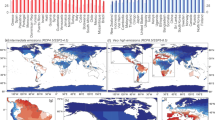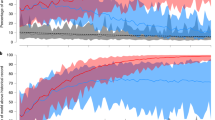Abstract
As climate change unfolds, weather systems in the United States have been shifting in patterns that vary across regions and seasons1,2,3,4,5,6,7. Climate science research typically assesses these changes by examining individual weather indicators, such as temperature or precipitation, in isolation, and averaging their values across the spatial surface. As a result, little is known about population exposure to changes in weather and how people experience and evaluate these changes considered together. Here we show that in the United States from 1974 to 2013, the weather conditions experienced by the vast majority of the population improved. Using previous research on how weather affects local population growth8,9,10,11,12,13,14 to develop an index of people’s weather preferences, we find that 80% of Americans live in counties that are experiencing more pleasant weather than they did four decades ago. Virtually all Americans are now experiencing the much milder winters that they typically prefer, and these mild winters have not been offset by markedly more uncomfortable summers or other negative changes. Climate change models predict that this trend is temporary, however, because US summers will eventually warm more than winters. Under a scenario in which greenhouse gas emissions proceed at an unabated rate (Representative Concentration Pathway 8.5), we estimate that 88% of the US public will experience weather at the end of the century that is less preferable than weather in the recent past. Our results have implications for the public’s understanding of the climate change problem, which is shaped in part by experiences with local weather15,16,17,18,19,20. Whereas weather patterns in recent decades have served as a poor source of motivation for Americans to demand a policy response to climate change, public concern may rise once people’s everyday experiences of climate change effects start to become less pleasant.
This is a preview of subscription content, access via your institution
Access options
Subscribe to this journal
Receive 51 print issues and online access
$199.00 per year
only $3.90 per issue
Buy this article
- Purchase on Springer Link
- Instant access to full article PDF
Prices may be subject to local taxes which are calculated during checkout



Similar content being viewed by others
References
Melillo, J. M., Richmond, T. C. & Yohe, G. W. Climate Change Impacts in the United States: The Third National Climate Assessment (US Global Change Research Program, 2014)
Gaffen, D. J. & Ross, R. J. Increased summertime heat stress in the US. Nature 396, 529–530 (1998)
Peterson, T. C. et al. Monitoring and understanding changes in heat waves, cold waves, floods, and droughts in the United States: state of knowledge. Bull. Am. Meteorol. Soc. 94, 821–834 (2013)
Menne, M. J., Williams, C. N. Jr & Vose, R. S. The U.S. Historical Climatology Network monthly temperature data, version 2. Bull. Am. Meteorol. Soc. 90, 993–1007 (2009)
Oswald, E. M. & Rood, R. B. A trend analysis of the 1930–2010 extreme heat events in the continental United States. J. Appl. Meteorol. Climatol. 53, 565–582 (2014)
Kunkel, K. E. et al. Regional Climate Trends and Scenarios for the U.S. National Climate Assessment: Part 9, Climate of the Contiguous United States (National Oceanic and Atmospheric Administration, 2013)
Kumar, S., Kinter, J. III, Dirmeyer, P. A., Pan, Z. & Adams, J. Multidecadal climate variability and the “warming hole” in North America: results from CMIP5 twentieth- and twenty-first-century climate simulations. J. Clim. 26, 3511–3527 (2013)
Glaeser, E. L., Kolko, J. & Saiz, A. Consumer city. J. Econ. Geogr. 1, 27–50 (2001)
Glaeser, E. L. & Shapiro, J. M. Urban growth in the 1990s: is city living back? J. Reg. Sci. 43, 139–165 (2003)
Glaeser, E. L. Reinventing Boston: 1640–2003. J. Econ. Geogr. 5, 119–153 (2005)
Mueser, P. R. & Graves, P. E. Examining the role of economic opportunity and amenities in explaining population redistribution. J. Urban Econ. 37, 176–200 (1995)
McGranahan, D. A. Natural Amenities Drive Rural Population Change (Economic Research Service, US Department of Agriculture, 1999)
Partridge, M. D. The dueling models: NEG vs amenity migration in explaining US engines of growth. Pap. Reg. Sci. 89, 513–536 (2010)
Rappaport, J. Moving to nice weather. Reg. Sci. Urban Econ. 37, 375–398 (2007)
Deryugina, T. How do people update? The effects of local weather fluctuations on beliefs about global warming. Clim. Change 118, 397–416 (2013)
Egan, P. J. & Mullin, M. Turning personal experience into political attitudes: the effect of local weather on Americans’ perceptions about global warming. J. Polit. 74, 796–809 (2012)
Howe, P. D., Markowitz, E. M., Lee, T. M., Ko, C.-Y. & Leiserowitz, A. Global perceptions of local temperature change. Nature Clim. Chang. 3, 352–356 (2013)
Joireman, J. A., Truelove, H. B. & Duell, B. Effect of outdoor temperature, heat primes and anchoring on belief in global warming. J. Environ. Psychol. 30, 358–367 (2010)
Li, Y., Johnson, E. J. & Zaval, L. Local warming: daily temperature change influences belief in global warming. Psychol. Sci. 22, 454–459 (2011)
Zaval, L., Keenan, E. A., Johnson, E. J. & Weber, E. U. How warm days increase belief in global warming. Nature Clim. Chang. 4, 143–147 (2014)
National Oceanic and Atmospheric Administration. Global Surface Summary of the Day (National Centers for Environmental Information, 2014)
Menne, M. J., Williams, C. N. Jr & Vose, R. S. United States Historical Climatology Network Daily Temperature, Precipitation, and Snow Data (Carbon Dioxide Information Analysis Center, 2015)
Cragg, M. I. & Kahn, M. E. Climate consumption and climate pricing from 1940 to 1990. Reg. Sci. Urban Econ. 29, 519–539 (1999)
Brown, P. J. & DeGaetano, A. T. Trends in US surface humidity, 1930–2010. J. Appl. Meteorol. Climatol. 52, 147–163 (2013)
Deser, C., Knutti, R., Solomon, S. & Phillips, A. S. Communication of the role of natural variability in future North American climate. Nature Clim. Chang. 2, 775–779 (2012)
Thrasher, B. et al. New downscaled climate projections suitable for resource management in the US. Eos Trans. AGU 94, 321–323 (2013)
Alder, J. R. & Hostetler, S. W. USGS National Climate Change Viewer (US Geological Survey, 2013)
van Vuuren, D. P. et al. The representative concentration pathways: an overview. Clim. Change 109, 5–31 (2011)
Taylor, K. E., Stouffer, R. J. & Meehl, G. A. An overview of CMIP5 and the experiment design. Bull. Am. Meteorol. Soc. 93, 485–498 (2012)
Lehner, F. & Stocker, T. F. From local perception to global perspective. Nature Clim. Chang. 5, 731–734 (2015)
Minnesota Population Center. National Historical Geographic Information System: Version 2.0 (Univ. of Minnesota, 2011)
Dutch Ministry of Infrastructure and Environment. KNMI Climate Change Atlas (Royal Netherlands Meteorological Institute, 2015)
New, M., Todd, M., Hulme, M. & Jones, P. Precipitation measurements and trends in the twentieth century. Int. J. Climatol. 21, 1889–1922 (2001)
Karl, T. R., Knight, R. W. & Plummer, N. Trends in high-frequency climate variability in the twentieth century. Nature 377, 217–220 (1995)
Karl, T. R. & Knight, R. W. Secular trends of precipitation amount, frequency, and intensity in the United States. Bull. Am. Meteorol. Soc. 79, 231–241 (1998)
Hanigan, I., Hall, G. & Dear, K. B. G. A comparison of methods for calculating population exposure estimates of daily weather for health research. Int. J. Health Geogr. 5, 38 (2006)
Barreca, A. I. Climate change, humidity, and mortality in the United States. J. Environ. Econ. Manage. 63, 19–34 (2012)
Wanielista, M., Kersten, R. & Eaglin, R. Hydrology: Water Quantity and Quality Control 2nd edn (Wiley, 1997)
Stull, R. B. Meteorology for Scientists and Engineers 2nd edn (Brooks/Cole, 2000)
Hubbard, K. G. & Lin, X. Reexamination of instrument change effects in the U.S. Historical Climatology Network. Geophys. Res. Lett. 33, L15710 (2006)
Quayle, R. G., Easterling, D. R., Karl, T. R. & Hughes, P. Y. Effects of recent thermometer changes in the cooperative station network. Bull. Am. Meteorol. Soc. 72, 1718–1723 (1991)
Ruggles, S. J. et al. Integrated Public Use Microdata Series: Version 5.0 (Univ. of Minnesota, 2014)
Sheffield, J. et al. North American climate in CMIP5 experiments. Part I: evaluation of historical simulations of continental and regional climatology. J. Clim. 26, 9209–9245 (2013)
Acknowledgements
We thank J. Alder, S. Anderson, A. Barreca, N. Beck, C. Dawes, S. Gordon, M. Hetherington, S. McDermid, J. Rappaport, M. Siegal and M. Smith.
Author information
Authors and Affiliations
Contributions
P.J.E. and M.M. conceived the study. M.M. compiled the geographical data and weather data. P.J.E. performed the modelling. P.J.E. and M.M. analysed the results and wrote the paper.
Corresponding author
Ethics declarations
Competing interests
The authors declare no competing financial interests.
Additional information
The data and code needed to reproduce results have been deposited at P.J.E.’s Harvard University Dataverse website (https://dataverse.harvard.edu/dataverse/patrickegan).
Extended data figures and tables
Extended Data Figure 1 Stations and counties in weather data set.
Green markers indicate GSOD weather stations (temperature and humidity data; n = 324). Purple markers indicate USHCN weather stations (precipitation data; n = 601). Shaded counties are those with valid weather data (n = 3,037). Only counties with population centroids within 160 km of at least one GSOD station and one USHCN station, both reporting valid data, were included in the analysis.
Extended Data Figure 2 Change in WPI and GSOD weather stations per county.
Map shows population growth rate equivalent change in WPI by decade (same as Fig. 2b). Size of dots represents the number of GSOD weather stations assigned to each county.
Extended Data Figure 3 Voronoi analysis.
Map shows locations of GSOD weather stations (n = 233) and associated polygons used in Voronoi analysis (Extended Data Table 5).
Supplementary information
Supplementary Information
This file contains Supplementary Table 1. (PDF 117 kb)
Rights and permissions
About this article
Cite this article
Egan, P., Mullin, M. Recent improvement and projected worsening of weather in the United States. Nature 532, 357–360 (2016). https://doi.org/10.1038/nature17441
Received:
Accepted:
Published:
Issue Date:
DOI: https://doi.org/10.1038/nature17441
This article is cited by
-
Future continental summer warming constrained by the present-day seasonal cycle of surface hydrology
Scientific Reports (2020)
-
Organosiliceous nanotubes with enhanced hydrophobicity and VOCs adsorption performance under dry and humid conditions
Journal of Porous Materials (2020)
-
Contesting the climate
Climatic Change (2020)
-
Mild weather changes over China during 1971–2014: Climatology, trends, and interannual variability
Scientific Reports (2019)
-
Large increase in global storm runoff extremes driven by climate and anthropogenic changes
Nature Communications (2018)
Comments
By submitting a comment you agree to abide by our Terms and Community Guidelines. If you find something abusive or that does not comply with our terms or guidelines please flag it as inappropriate.



